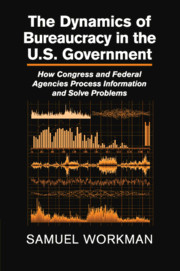 The Dynamics of Bureaucracy in the US Government
The Dynamics of Bureaucracy in the US Government Published online by Cambridge University Press: 05 May 2015
The primary business of government is understanding and responding to problems. Democratic systems must address important and salient policy problems facing citizens, groups, and policy makers. This simple assumption is relevant to understanding not only the part played by bureaucracy in policy making but also democracy itself in a system in which citizens rely on elected officials and bureaucrats alike to address and solve problems they deem important. Put another way, democratic control of the federal administrative apparatus is meaningless if elected officials do not muster bureaucratic might in an effort to address policy problems important to attentive citizens. The quality of democracy depends in part on whether important problems make their way to elected officials for consideration and decision.
What Is the Administrative State?
Dual dynamics characterize the relationship between the bureaucracy and Congress and govern policymaking in what Dodd and Schott (1986) famously termed the administrative state. By “administrative state,” I mean the set of administrative and elected institutions that make policy on a day-to-day basis on various issues. The most significant bureaucracies and congressional institutions, especially committees, are those involved in monitoring and making policy in various issue areas. The administrative state also includes actors less visible in the process such as committee staff. In the terms of a much older literature, the administrative state is the collection of subsystems governing policy making in more or less defined issue areas.
What Is a Problem?
Given that government is geared toward processing information about policy problems, it is worth defining what constitutes a policy problem. The institutions of government must be able to detect problems, generate information about them, and formulate a definition of them that allows the generation of solutions or alternatives. Simon (1979, p. 147) likens the defining of policy problems to a maze (also see Dery, 1984, p. 25). Whereas most scholarship addresses the choice among alternatives (i.e., different paths through the maze), problem definition involves the construction of the maze itself.
To save this book to your Kindle, first ensure [email protected] is added to your Approved Personal Document E-mail List under your Personal Document Settings on the Manage Your Content and Devices page of your Amazon account. Then enter the ‘name’ part of your Kindle email address below. Find out more about saving to your Kindle.
Note you can select to save to either the @free.kindle.com or @kindle.com variations. ‘@free.kindle.com’ emails are free but can only be saved to your device when it is connected to wi-fi. ‘@kindle.com’ emails can be delivered even when you are not connected to wi-fi, but note that service fees apply.
Find out more about the Kindle Personal Document Service.
To save content items to your account, please confirm that you agree to abide by our usage policies. If this is the first time you use this feature, you will be asked to authorise Cambridge Core to connect with your account. Find out more about saving content to Dropbox.
To save content items to your account, please confirm that you agree to abide by our usage policies. If this is the first time you use this feature, you will be asked to authorise Cambridge Core to connect with your account. Find out more about saving content to Google Drive.